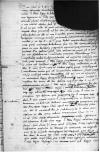... nuntium ⌊serenissimae maiestatis regiae⌋ nobile[m] [⌊Christophorum Konarsky⌋] ... eius legatione in omnibus, quae ... abunde edoctum commendaticiisque [ad]... a me auctum absolvi, dedi item ... et ad eos, qui inibi non parum possunt ... commodo illorum procurando ad hoc iter non admod[um] ... proficiscatur, ut illi cum uno Lundensis panni stamine et quinquaginta marcarum nostratium pecuniola subvenirent. Quod adminiculum si non litterae Dominationis Vestrae Reverendissimae, quas habet, impetrabunt, nescio, si meae quid momenti habebunt. Duo enim illi ⌊citati⌋, ubi quippiam ex meo desiderio progressum agnoverint, strenue se opponunt.
Pro ⌊quibus⌋ (quod satis mirari non possum
<)>
ab ⌊eo⌋, qui pro me praesidebat, in ⌊conventu proximo ⌊Marienburgi⌋⌋ ⌊domini consiliarii⌋ inducti, dissimulantes vel nescientes citationis causam, satis animose serenissimae ⌊maiestati regiae⌋ scripserunt. Quae litterae sic missae sunt ad ⌊syndicum⌋, ut serenissimae ⌊maiestati regiae⌋ redderentur, ne de illis Dominatio Vestra Reverendissima notitiam habere possit. Quarum exemplum, quod ⌊cancellarius⌋ meus, quem ad conventum miseram, secreto nactus est, iis inclusum mitto. Ad eas me non consensisse, ut auctoritati regiae derogetur quodque tribunal regium remotum et insolens ⌊his terris⌋ dici debeat, impense rogo, Dominatio Vestra Reverendissima protestationem ex me serenissimae ⌊maiestati regiae⌋ faciat .
In illis litteris fides erga serenissimam ⌊maiestatem regiam⌋ ⌊citatorum⌋ supra fidem commendatur. Quam neque ego admodum impugno. Quomodo autem recta et vera in principem esse debeat, cum praepostera sit et iniqua erga Deum et Eius vivum Corpus et Sanguinem? ⌊Ipsi⌋
videant
. Cui, ut hostes, ne honorem exhiberent debitum, manifesto processioni, quae illo die, utpote Corporis Christi apud omnes pios Christianos solemnis est et venerabilis, se subduxerunt et alios suos complices ex illa extra ⌊urbem⌋ traxerunt. Qua in re, cum iam satis superque aliquoties , nulla affectione, sed conscientia et fide mea erga serenissimam ⌊maiestatem regiam⌋ adactus, scripserim, finem facio.
Ceterum, quod generoso domino ⌊castellano Gedanensi⌋ profectio in ⌊Daniam⌋ sit iniuncta, non improbarem, si eam commode transigere posset. Quod qua de re hoc duro brumae tempore fieri nequeat, et quae interim commodo esse mihi visa sint pro rudi meo captu, in ⌊⌋ serenissimae ⌊maiestati regiae⌋ descripsi.
⌊Cui⌋ , quod ad ⌊regni comi[tia] ...⌋ ut me Dominatio Vestra Reverendissima dictatorem adhuc ...ns et plurimum oro, sunt enim in me (qu... ...corrosimus) maria et flumina congelata, quae ...cio, non nisi ferventiore sole resolventur ... in Dominum Deum spero serenissimam ⌊maiestatem regiam⌋ ...m et hic amplius non ero Dominationemque Vestram Reverendissimam ...mem videbo aliquando cupidissime.
Quam oro, ut me habeat commendatissimum meque veteri sua benevolentia prosequi non desinit et sic me in corpore et animo affectum a profectionibus et malevolis meis tueatur.
Eandem Dominationem Vestram Reverendissimam ad prorogatissima tempora salvam et felicem esse ex animo cupio.

